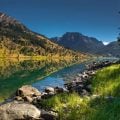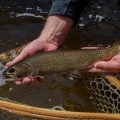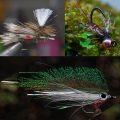Norway’s Målselv River: “Fifty More Places To Fly Fish Before You Die”
“WORKING AROUND the fly-fishing travel world, I meet many international anglers who have checklists of the fisheries they must visit before they die,” Mark Hewetson-Brown began. “The Målselv is not one of the Atlantic salmon rivers that appear on their radar—but for me, that’s part of its appeal. It’s not one of the big well-known rivers in Norway, but because of that, it’s relatively easy to access and is reasonably priced.”
Next to New Brunswick, no area of the world may be more closely associated with Atlantic salmon—particularly large Atlantic salmon—than Norway. More than 600 rivers in this glacier-sculpted land support healthy fish runs. Tales of Norway’s output are legend among salmon anglers—on one July evening in 1926, the Duke of Westminster landed thirty-three fish—a total of more than 800 pounds—including two beasts of 42 pounds and one of 45 pounds. (This epic outing transpired on the grande dame of Norwegian rivers, the Alta, which currently has a bit of a waiting list for beats… and a long line of interested parties eager to pay the tens of thousands of dollars the beats command.)
The Målselv rests above the Arctic Circle in Troms, Norway’s second northernmost region. Non-angling visitors (and many Norwegians) may know the river for the Målselvfossen, a waterfall that is one of Norway’s signature landmarks. Below Målselvfossen, the Målselv seems devoid of the features that make a prime salmon stream; above the falls, it’s another matter in a fishery marked by run after run of water begging to be swung through with a fly.
Like many fishermen’s best finds, Mark came upon the Målselv by accident. “A fellow contacted me to see if I’d like to assess a fishing operation in northern Sweden,” he recounted. “He said that he lived near a nice river in Norway, that we could do some fishing there too. I did an exploratory trip with two clients, and it was a disaster. The fellow was a charlatan. But one good thing did come out of it. He showed me the Målselv and introduced me to a guy named Tony Jacobsen. Tony is an ambulance driver, but more importantly, a hard-core angler. He fishes with his ambulance uniform under his waders and the ambulance by the riverbank. When the phone rings, he strips off his waders and heads off to wherever he’s needed. Tony and I made arrangements to stay in touch, and I visited him the following year. I was struck with the river and the region, won over by the lack of development. The angling is very relaxed, fun, and old-fashioned. A case in point—I met a schoolteacher who camps by the river for the whole summer holidays. He can afford to rent the beat for the whole summer.”
The Målselv may not kick out 40-plus-pound monsters with the consistency of the Alta to the north, but fish in the 20s are caught with some frequency, 30-plus salmon show up each year, and 40-pound fish are rare but there. One of the pleasures of the fishery is the quality and diversity of its holding water. “There’s not much in the way of big slow pools,” Mark said. “There are many classic runs with tailouts that are a joy to fish. It’s not a beginner’s river. To succeed, anglers have to be able to cast a fair line. If the river is up and dirty, you need to be able to throw a sinking line. The good news is the river clears extremely quickly. One day when I was out fishing, the river came up 3 feet in the morning. By the afternoon, it was clear.”
Not surprisingly, a spey rod is the weapon of choice on the Målselv. Spey rods and spey casting have gained increasing traction in recent years among salmon and steelhead anglers who need to cover large pieces of water to locate their quarry. Instead of making a backcast—or multiple backcasts—to accelerate the fly line forward, spey casters use the tension of the water to harness the power of the longer spey rod (generally 12 to 16 feet in length) to make what resembles an exaggerated roll cast. With a modern spey rod in hand, casts of 80, 90, or 100 feet are well within the grasp of mere mortal anglers. The first spey rods were hewn from ash, and by all reports, were not unlike wielding a tree branch. Even twenty-five years ago, two-handed rods were ungainly beasts. “When I was introduced to spey casting, the weapon of choice was the Double-Built Palakona manufactured by Hardy,” spey casting expert Simon Gawesworth said. “It was 18 feet long, had two layers of split cane, and steel shaft in the middle. It weighed 54 ounces. It was a rod for real men.” In the last few decades, many innovations in spey casting technique and technology have come from Scandinavia, most notably from a Swedish angler named Göran Andersson. Andersson introduced an outfit that combined a shorter, stiffer spey rod with a shooting head and slick, small diameter shooting line. Today’s it’s generally referenced as “Scandi-” or “Underhand-”style casting.
“Unlike some Norwegian rivers, fishing on the Målselv is all bank fishing,” Mark added. “There are no boats paddling about in the middle of the river. The fish seem to like a slightly faster fly, so you cast a bit further down than you might on other rivers. The locals use chunky tippet material and really give the fish the beans once they’re on. If you let the fish get into the fast water, they can make a mockery of you. Local riverkeepers are happy to see anglers from the UK or USA, as nearly all of these visitors practice catch and release. When Norwegians catch a fish, it generally gets thumped, though many are trying to improve this.”
During prime time on the Målselv the sun shines twenty-four hours—though fishing is limited to the period from 6 a.m. through midnight. “In the past, I’ve stayed at a guesthouse on the banks of the Målselv, a stone’s throw from the beats we fish,” Mark said. “I like to be on the river by six, come back for a late breakfast, head out again and have lunch on the river, then have dinner at the guesthouse and head back out for the evening’s fishing. Many of the beats come with a simple cabin. If you want eighteen-hour access to your beat and are not bothered by camping, you can cook and warm up in the cabin (which has heat) and set up a tent outside for sleeping. During some of our after-dinner sessions, a friend of Tony’s would join us at the cabin. He’d bring along smoked reindeer meat, which we’d fry up with some butter, wrap in bread, and wash down with some Aquavit—a true taste of Norwegian salmon fishing!”
Mark Hewetson-Brown is a long-standing member of the team at Frontiers Travel International, based in Gloucestershire, England. He joined Frontiers Ponoi River team in Russia in 2003, spending three seasons guiding at Ryabaga, while spending his winters working at the Frontiers U.S. office, coordinating driven shooting trips in Europe. Since October 2005 he has been a full-time member of Frontiers’ European office, where he looks after shooting in Great Britain and Europe, shooting in South America, and fishing in Russia and South America. Mark spent the majority of his formative years with either a rod or gun in hand, either on the family farm in Hampshire or in southwest Ireland. He is a graduate of Newcastle University.
Prime Time: The season on the Målselv runs from mid-June through September, with the middle portion of the season often providing the best fishing.
Getting There: Guests generally fly into Tromsø, the primary air hub in northern Norway, which is served via Oslo. Several carriers provide service from the United States to Oslo, Norway, including SAS (800-221-2350) and Iceland Air (800-223-5500). The village of Rundhaug is approximately two hours’ drive from Tromsø.
Accommodations: Many anglers fishing the Målselv will stay at Rundhaug Gjestegård (+47 77 83 05 70), a comfortable guesthouse near the river which also provides meals.
Guides/Outfitters: Beats on the upper section of the Målselv are available from Frontiers Travel International (+44 845 299 6212).
Equipment: An 8-weight spey rod will enable a proficient caster to cover the water well on the Målselv. Reels should be outfitted with floating, intermediate sinking and sink-tip lines, with 200 yards of backing. Tube flies in black and blue work well.
Copyright © 2011 Chris Santella. Excerpted from Fifty More Places To Fly Fish Before You Die with permission from Stewart, Tabori & Chang.












